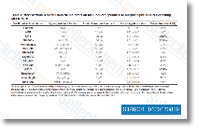In contrast, MT3 and MT4 are expressed largely inside the cen tral nervous system and squamous epithelia, Hence, it really is probably that, at the least during the brain, MT3 may perhaps serve as being a crucial supply for dynamically exchangeable zinc in cells exposed to various pressure stimuli. MT3 was originally recognized as a neuronal growth inhibitory issue that inhibited outgrowth of rat cortical neurons from the presence of Alzheimers ailment brain extracts, This effect is not shared by MT1 or MT2, and is probably because of the one of a kind presence of the TCPCP motif inside of the b domain of MT3, The precise mechanism underlying the neurite out development inhibitory result of MT3 remains poorly under stood, but a number of scientific studies have implicated MT3 in different neurological conditions.
Altered MT3 expression is also reported in amyotrophic lateral sclerosis, Down selleck chemicals MLN0128 syndrome, pontosubicular necrosis, Parkinsons illness, meningitis, and Creutzfeld Jakob illness, In addition, MT3 appears to exert both protective and injury advertising results in experimental models of brain injury. The neuroprotective results of MT3, that are presumably because of its metal chelating and antioxida tive results, are evident in epileptic brain damage, cortical cryolesions, a mutant superoxide dismu tase 1 mouse model of ALS, and peripheral nerve injury, Various researchers have demonstrated the opposite phenomenon, showing such as that intracellular zinc launched from MT3 could trigger neuronal death in vivo and in vitro, indicating the injury promoting effects of MT3, In adult brains, MT3 is predominantly expressed in neurons, but in establishing brains it’s also drastically expressed in astrocytes.
We now have demonstrated the maximize in intracellular no cost zinc induced by oxidative injury is drastically lowered in cultured MT3 null astrocytes in contrast with wild type cells, Also, cell death is additionally attenuated in MT3 null cells. These effects offer added help for that notion selelck kinase inhibitor that MT3 will be the principal source for elevations in toxic free of charge zinc in acute brain injury. Interestingly, even though astrocytes  express substantial amounts of MT1 and MT2, experiments using small interfering RNAs suggest that these MTs usually do not participate as zinc donors.
express substantial amounts of MT1 and MT2, experiments using small interfering RNAs suggest that these MTs usually do not participate as zinc donors.
No related posts.
